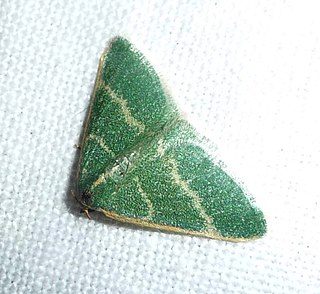
Aegocera is a genus of moths of the family Noctuidae first described by Pierre André Latreille in 1809.

Carmara is a monotypic moth genus of the family Noctuidae. Its only species, Carmara subcervina, is found in Sri Lanka, Japan, Taiwan, Borneo and Australia. Both the genus and species were first described by Francis Walker in 1864.
Brachiolia egenella is a species of moth of the family Tortricidae first described by Francis Walker in 1864. It is found in Sri Lanka, India, South Africa and on the Comoros and Mauritius.
Trypanophora trapobanes is a moth in the Zygaenidae family. It was described by Francis Walker in 1854 from Sri Lanka. Its larval host plants are in the genus Lagerstroemia.
Barsine defecta is a moth of the family Erebidae first described by Francis Walker in 1854. It is found in Sri Lanka, Nepal, Thailand and Vietnam. It is the type species of genus Barsine.
Casama vilis is a moth of the family Erebidae first described by Francis Walker in 1865. It is found in Sri Lanka, India, Middle East, Ethiopia, Kenya and Somalia.
Cusuma vilis is a moth of the family Geometridae first described by Francis Walker in 1854. It is found in Sri Lanka.

Hypomecis transcissa is a moth of the family Geometridae first described by Francis Walker in 1860. It is found in the Indian subregion and from Sri Lanka to Sundaland.

Microloxia herbaria, the herb emerald, is a moth of the family Geometridae. The species was first described by Jacob Hübner in 1808. It is a widespread species that can be found along the Mediterranean region, southern Europe, central Asia towards southern Asia including India, Pakistan and Sri Lanka and to the Russian Far East.

Callyna jugaria is a moth of the family Noctuidae first described by Francis Walker in 1858. It is found in Sri Lanka, India, China, Taiwan, Hong Kong and the Philippines.

Callyna monoleuca is a moth of the family Noctuidae first described by Francis Walker in 1858. It is found in Sri Lanka, India, China, Japan, Taiwan, Myanmar, Indonesia, New Guinea and Australia.

Avitta quadrilinea is a moth of the family Noctuidae first described by Francis Walker in 1863. It is found in Borneo, Peninsular Malaysia, Thailand, the Indian subregion, the Philippines, Sulawesi and Sri Lanka.
Avitta subsignans is a moth of the family Noctuidae first described by Francis Walker in 1858. It is found in the Indian subregion and Sri Lanka.
Leucania roseilinea, the grain army worm, is a moth of the family Noctuidae. The species was first described by Francis Walker in 1862. It is found in Sri Lanka, Myanmar, Sundaland, the Philippines to New Guinea.
Catada vagalis is a moth of the family Erebidae first described by Francis Walker in 1858. It is found in India, Sri Lanka, Peninsular Malaysia, Borneo and the Philippines.
Dichromia thermesialis is a moth of the family Erebidae first described by Francis Walker in 1866. It is found in India, Sri Lanka, China, Sumatra, Borneo and New Guinea.

Rivula aequalis is a moth of the family Erebidae first described by Francis Walker in 1863. It is found in Sri Lanka, the Indian subregion, Japan, Sundaland, the Philippines and Sulawesi.
Hypena abyssinialis, the streaked snout, is a moth of the family Erebidae. The species was first described by Achille Guenée in 1854. It is found in many African and South Asian countries.
Thosea aperiens, the stinging caterpillar, is a moth of the family Limacodidae. The species was first described by Francis Walker in 1865. It is found in Sri Lanka and India.
Mathoris loceusalis is a moth of the family Thyrididae first described by Francis Walker in 1859. It is found in India, Sri Lanka and Australia.








